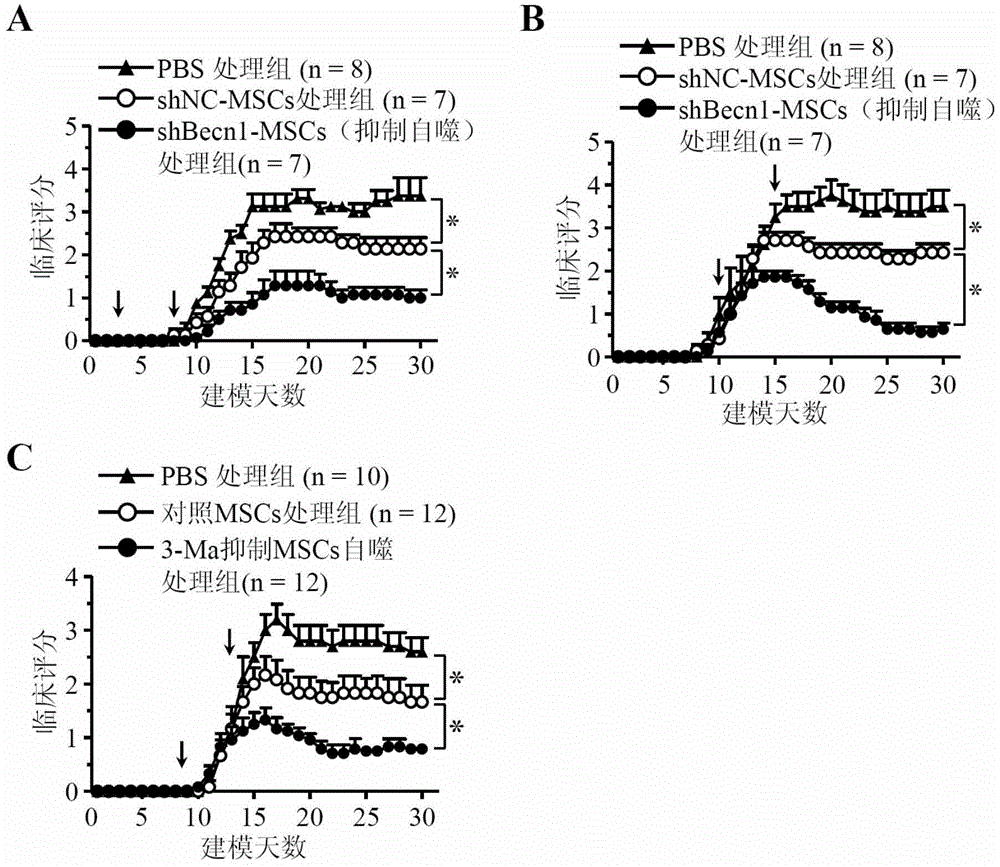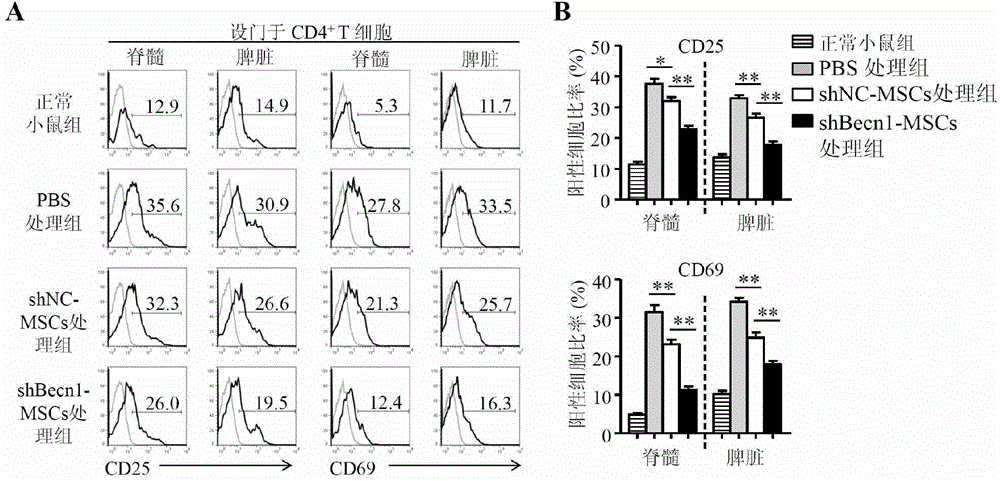Application of inhibiting autophagy of mesenchymal stem cell in autoimmune disease
An autoimmune and mesenchymal stem cell technology, applied in the direction of allergic diseases, genetic material components, medical preparations containing active ingredients, etc., can solve the problems of weakening the therapeutic effect of inflammatory diseases and reducing immune function
- Summary
- Abstract
- Description
- Claims
- Application Information
AI Technical Summary
Problems solved by technology
Method used
Image
Examples
Embodiment 1
[0084] Inhibition of autophagy in mesenchymal stem cells enhances their immunosuppressive ability against experimental allergic meningitis (EAE)
[0085] METHODS: Mice aged 6-8 weeks were randomly divided into groups and immunized with synthetic myelin protein peptides to establish an animal model of experimental allergic cerebrospinal meningitis (EAE). Prophylactic treatment with vehicle (PBS), control MSCs (shNC-MSCs) and autophagy-inhibited MSCs (shBecn1-MSCs) were used on the 3rd and 8th day of modeling, respectively, and on the 10th and 15th day of modeling PBS, shNC-MSCs and shBecn1-MSCs were used for therapeutic treatment, respectively, and the incidence of the three groups of mice was observed.
[0086] Scoring criteria: 0: no disease; 1: tail weakness; 2: slight hindlimb weakness; 3: severe hindlimb paralysis; 4: quadriplegia; 5: dying or dying.
[0087] Results: Silenced Beclin-1 expression inhibited the disease scores of mice treated with autophagy after preventive...
Embodiment 2
[0090] Inhibition of MS autophagy on CD4 + T cell role detection
[0091] Method: According to the results of Example 1, it was further determined to inhibit MS autophagy on CD4 + The role of T cells, that is, detection and analysis of CD4 in EAE mice treated with PBS, shNC-MSCs and shBecn1-MSCs + T cells,
[0092] Results: The experiment found that the shBecn1-MSCs treatment group EAE mice CD4 + The level of T cell activation was significantly lower than that of the shNC-MSCs treatment group, and the expression levels of T cell activation markers CD25 and CD69 were lower than those of the shNC-MSCs treatment group (see image 3 A, 3B).
[0093] detect CD4 + After the proliferation of T cells in vivo, it was found that BrdU+ CD4 in the target organ spinal cord and peripheral immune organ spleen in the shBecn1-MSCs treatment group EAE mice + T cells, proliferating CD4 + T cells, significantly less than the shNC-MSCs-treated group (see Figure 4 A).
[0094] Further usi...
Embodiment 3
[0097] Inhibition of autophagy can enhance the immunosuppressive function of mesenchymal stem cells
[0098] Method: Activated CD4 + T cells were co-cultured with shNC-MSCs and shBecn1-MSCs. CFSE and 3H incorporation methods were used to detect the proliferation of T cells, and real-time quantitative polymerase chain reaction was used to detect the expression levels of effector molecules that MSCs exerted immunosuppressive functions.
[0099] Result: CD4 + The ratio of T cells to MSCs ranged from 10:1 to 50:1, and shBecn1-MSCs could inhibit CD4 more strongly than shNC-MSCs + Proliferation of T cells (see Figure 5 A, 5B).
[0100] Experiments have shown that the mRNA expression of COX-2 is up-regulated after autophagy is inhibited, and the expression of COX-2 is further up-regulated under the combined stimulation of inflammatory factors TNF-α and IFN-γ (see Figure 6 A), This result was further confirmed at the protein level using immunoblotting (see Figure 6 B).
PUM
 Login to View More
Login to View More Abstract
Description
Claims
Application Information
 Login to View More
Login to View More - R&D
- Intellectual Property
- Life Sciences
- Materials
- Tech Scout
- Unparalleled Data Quality
- Higher Quality Content
- 60% Fewer Hallucinations
Browse by: Latest US Patents, China's latest patents, Technical Efficacy Thesaurus, Application Domain, Technology Topic, Popular Technical Reports.
© 2025 PatSnap. All rights reserved.Legal|Privacy policy|Modern Slavery Act Transparency Statement|Sitemap|About US| Contact US: help@patsnap.com



